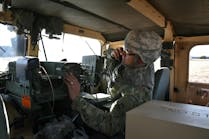PALO ALTO, Calif., 22 May 2006. Lockheed Martin announced that the Solar X-ray Imager (SXI) instrument, designed and built at its Space Systems Advanced Technology Center (ATC), is scheduled to be launched this week.
Built for the NASA Goddard Space Flight Center (GSFC) in Greenbelt, Md., SXI will take flight May 24 on the National Oceanic and Atmospheric Administration (NOAA) Geostationary Operational Environmental Satellites (GOES) spacecraft from Cape Canaveral Air Force Station, Fla.
The SXI, one of a suite of instruments on the GOES-N satellite, will aid NOAA and U.S. Air Force personnel in issuing forecasts and alerts of "space weather" conditions.
Turbulent "space weather" can affect radio communication on Earth, induce currents in electric power grids and long distance pipelines, cause navigational errors in magnetic guidance systems, upset satellite circuitry and expose astronauts to increased radiation.
SXI will observe solar flares, coronal mass ejections, coronal holes, and active regions in the X-ray region of the electromagnetic spectrum from 6 to 60 A (Angstroms). SXI will also examine flare properties, newly emerging active regions, and X-ray bright points on the Sun.
SXI will provide continuous, near real-time observation of the Sun's corona, acquiring a full-disk image every minute. The images cover a 42 arc-minute field of view with five arc-second pixels.


